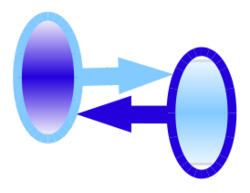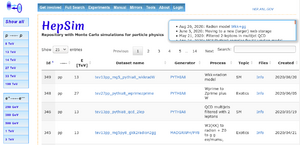Physics:HepSim
HepSim [1] is a public repository with theoretical predictions for particle physics for particle accelerators (collider) experiments. It includes data samples with outputs of Monte Carlo generators, typically generated at leading-order QCD as well as fixed order. The HepSim repository is created at the Argonne National Laboratory and leverages its computational resources, as well as the grid resource managed by Open Science Grid Consortium. The main motivation for the project was to be able to use large event samples for physics and detector performance studies without additional authentication which is usually required for the grid resources.
 | |
 HepSim homepage, 2020 | |
Type of site | Online repository |
|---|---|
| Available in | English |
| Headquarters | |
| Created by | S.V.Chekanov |
| Website | https://atlaswww.hep.anl.gov/hepsim/ |
| Commercial | No |
| Registration | Yes (Required to edit pages, via request of account) |
| Current status | Active |
Content license | CC BY-SA 3.0 |
The repository is available from the HepSim web page [2] and described in [3]. The web interface of this repository is mirrored at NERSC, JLab and CERN. The user-friendly overview of HepSim is given in [4] The list of publications and public talks based on the HepSim event samples are listed on the HepSim web page.
The main goal of the repository is a quick reconstruction of kinematic distribution using experiment-specific selection, kinematic cuts and histogram bins. The processing time for such samples is relatively small, while in many cases, the CPU time to generate event samples is substantial. Another important goal of HepSim is a long-term preservation of theoretical predictions and possibility to have reference event-based predictions for experimentalists and theorists. For example, common samples with event generator outputs can be useful for comparison between different collider experiments that often use different selection cuts. The HepSim samples can also be used as a source for detector simulations using Geant4. This was featured on the FCC-mass media portal [5]
Approach
The main approach of the HepSim repository is to store events from Monte Carlo generators in the form of highly-compressed ProMC data format [6]. The data format uses variable-byte encoding and allows effective data storage and streaming over a network. The data can be read and analyzed using several programming languages on major operating systems (Windows, Mac OS, Linux).
HepSim data can be read and analyzed using ROOT data analysis framework (C++), Jas4pp environment and DataMelt environment. In many cases, data analysis can be done over a network using data streaming.
Available event samples
Currently, the following event generators are used for the HepSim repository:
Some large-scale Monte Carlo samples posted to the HepSim repository were featured in [7]
History and the Usage
The HepSim repository originally started as a project to deliver Monte Carlo generator samples for particle-physics community during the US long-term planning study of the American Physical Society’s Division of Particles and Fields (Snowmass 2013) [8]. Later, the main focus has been shifted from fast-detector simulation to truth-level Monte Carlo events for future proton-proton colliders, as well as to the full detector simulations. In particular, HepSim has an emphasis [9] on a hadron collider with a centre-of-mass energy of the order of 100 TeV. The repository is also discussed in the context of the electron-ion detector concepts [10]
References
- ↑ Online Particle Physics Information. CERN http://library.cern/particle_physics_information
- ↑ HepSim web page
- ↑ S.V. Chekanov. HepSim: a repository with predictions for high-energy physics experiments, Advances in High Energy Physics, vol. 2015, Article ID 136093, 2015. doi:10.1155/2015/136093
- ↑ D.Blyth, A Tour of HepSim From a User’s Perspective
- ↑ FCC news, May 31, 2016 https://fcc.web.cern.ch/Pages/news/Complex-detector-simulations-of-proton-collisions-for-FCC-.aspx
- ↑ S.Chekanov, E.May, K. Strand, P. Van Gemmeren, ProMC: Input-output data format for HEP applications using varint encoding, arXiv:1311.1229, Computer Physics Communications 185 (2014), pp. 2629-2635
- ↑ J.Sagoff. ANL news article. “Researchers create enormous simulation of proton collisions”. Argonne Science Highlights. December 12, 2014. http://www.anl.gov/articles/researchers-create-enormous-simulation-proton-collisions
- ↑ HEP Community Summer Study 2013, http://www.slac.stanford.edu/econf/C1307292/
- ↑ M. Beydler et al., Initial performance studies of a general-purpose detector for multi-TeV physics at a 100 TeV pp collider. Dec 2016. [[1]]. JINST 12 (2017) P06009.[[2]]
- ↑ W.Armstrong at al. "Full simulation and reconstruction of multiple EIC concept-detectors. https://agenda.infn.it/getFile.py/access?contribId=100&sessionId=8&resId=0&materialId=slides&confId=13037. Electron Ion Collider User Group Meeting 2017, Trieste (Italy), July 18- 22, 2017

